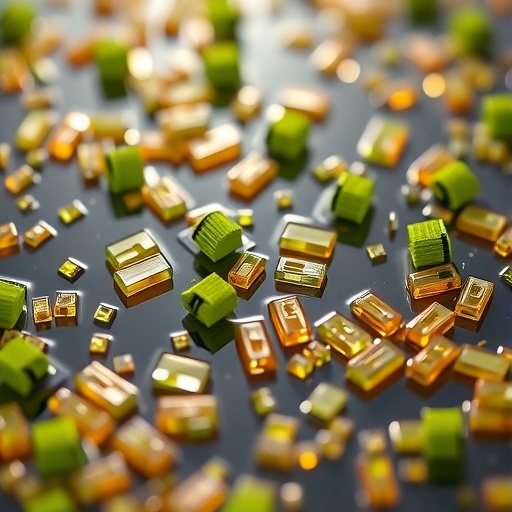Recent advances in sustainable technology have sparked a transformative approach to utilizing microalgae and agricultural byproducts as valuable resources for renewable energy and materials. A pioneering study conducted by researchers from Chongqing University has unveiled a groundbreaking process for converting Chlorella pyrenoidosa—a protein-rich microalga—and oilseed rape straw, typically regarded as waste, into useful products through a hydrothermal conversion method. This innovative technique demonstrates not only an efficient avenue for recycling biomass but also a significant leap towards a sustainable circular economy.
The hydrothermal conversion process utilized by the researchers operates at a temperature of 230 °C, employing a water-based environment that negates the need for either extensive drying or the use of harsh chemicals. This efficiency underscores the potential for reusing materials that would otherwise be discarded. The end products of this conversion include biofuels, bio-adsorbents, fluorescent carbon nanodots, and nutrient-rich water, all of which have varieties of applications in energy production and environmental remediation.
At the heart of this study lies the impressive yield of carbon dots—tiny, fluorescent particles measuring between 1.5 to 26 nanometers. These carbon dots possess the remarkable ability to emit bright blue light and showcase photocatalytic properties, making them ideal candidates for environmental clean-up initiatives. Notably, the conversion process resulted in the degradation of over 42 percent of the dye methylene blue from wastewater, revealing a promising capability for efficient pollutant removal.
Furthermore, the hydrochar produced from the oilseed rape straw exhibited exceptional adsorption properties. It effectively removed nearly 69 percent of methylene blue, with an adsorption capacity reaching up to 275 milligrams per gram. This material not only serves as a bio-adsorbent but also contributes to the production of solid fuels, which demonstrated an impressive energy content of 27.8 megajoules per kilogram. Such energy outputs are comparable to conventional biofuels, positioning this method as a viable alternative in the endeavor to transition towards sustainable energy sources.
The integration of these two biomaterials—microalgae and agricultural residues—sets the stage for a multi-faceted approach to sustainable energy production. The aqueous byproduct resulting from the conversion of microalgae has been found to hold incredible potential as a nutrient source for cultivating new algal biomass. This innovation effectively closes the recycling loop, allowing for a continuous cycle of biomass re-utilization and nutrient replenishment within ecosystems.
Professor Ao Xia, the corresponding author of the study, emphasized the significance of their findings, stating, “Our approach makes full use of both microalgae and crop residues to produce clean energy and valuable materials simultaneously. It offers an integrated pathway for sustainable waste utilization and carbon recycling.” This philosophy of utilizing waste materials aligns seamlessly with the broader goals of increasing efficiency in resource use and minimizing environmental impacts.
The methods presented in this research provide a comprehensive blueprint for future studies aiming to produce biofuels, nanomaterials, and biological nutrients from renewable biomass. By focusing on common agricultural residues and microalgae, scientists can explore more extensive applications and improvements in efficiency, leading to further advancements in the field of sustainable energy technologies.
In the context of increasing global concerns regarding climate change and environmental degradation, the potential applications of these findings are manifold. The ability to create valuable materials from waste reduces the carbon footprint of energy production while simultaneously addressing the challenge of waste management. Furthermore, as the world transitions towards a circular economy, approaches like these pave the way for integrating waste into the fabric of renewable resource systems.
The exploration of carbon dots also opens a new frontier in materials science, with implications for various industries, including electronics, medicine, and environmental science. Their properties enable researchers to develop innovative solutions for pollution control, making them essential tools in the fight against environmental contaminants.
In conclusion, the breakthrough research from Chongqing University signifies a major step forward in the quest for sustainable practices within energy production. The co-conversion of microalgae and agricultural byproducts marks a notable advancement in ecological innovation, underscoring the importance of utilizing renewable resources to address contemporary environmental challenges. Future studies will undoubtedly build upon this foundation, exploring new methods and technologies to further harness the potential of biomass in promoting a greener and more sustainable world.
The research published in the academic journal, Biochar, is a testament to the critical role of interdisciplinary collaboration in addressing global challenges. This exploration not only sheds light on innovative technological applications but also emphasizes the pressing need for ongoing research in bioengineering and environmental science, focusing on sustainable solutions capable of supporting a healthier planet.
Subject of Research: Not applicable
Article Title: Production of carbon dots, biofuels, bio-adsorbents, and biological nutrients via hydrothermal conversion of Chlorella pyrenoidosa and oilseed rape straw
News Publication Date: 11-Sep-2025
Web References: Biochar Journal
References: Zhang, J., Zhang, B., Xia, A. et al. Production of carbon dots, biofuels, bio-adsorbents, and biological nutrients via hydrothermal conversion of Chlorella pyrenoidosa and oilseed rape straw. Biochar 7, 109 (2025).
Image Credits: Jingmiao Zhang, Bin Zhang, Ao Xia, Qingming Zhou, Xianqing Zhu, Yun Huang, Xun Zhu & Qiang Liao
Keywords
Bioeconomy, Carbon dots, Hydrothermal conversion, Renewable energy, Environmental remediation.




